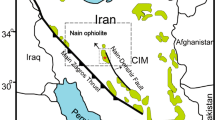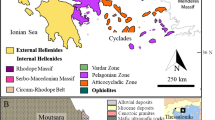Abstract
In this paper we present textural and mineral chemistry data for a PGM inclusion assemblage and whole-rock platinum-group element (PGE) concentrations of chromitite from Harold’s Grave, which occurrs in a dunite pod in a mantle tectonite at Unst in the Shetland Ophiolite Complex (SOC), Scotland. The study utilized a number of analytical techniques, including acid digestion and isotope dilution (ID) ICP-MS, hydroseparation and electron microprobe analysis. The chromitite contains a pronounced enrichment of refractory PGE (IPGE: Os, Ir and Ru) over less refractory PGE (PPGE: Rh, Pt and Pd), typical of mantle hosted ‘ophiolitic’ chromitites. A ‘primary’ magmatic PGM assemblage is represented by euhedrally shaped (up to 60 μm in size) single and composite inclusions in chromite. Polyphase PGM grains are dominated by laurite and osmian iridium, with subordinate laurite + osmian iridium + iridian osmium and rare laurite + Ir-Rh alloy + Rh-rich sulphide (possibly prassoite). The compositional variability of associated laurite and Os-rich alloys at Harold’s Grave fit the predicted compositions of experiment W-1200-0.37 of Andrews and Brenan (Can Mineral 40: 1705–1716, 2002) providing unequivocal information on conditions of their genesis, with the upper thermal stability of laurite in equilibrium with Os-rich alloys estimated at 1200–1250 °C and f(S2) of 10−0.39–10−0.07.





Similar content being viewed by others
References
Andrews DRA, Brenan JM (2002) Phase-equilibrium constraints on the magmatic origin of laurite and Os-Ir alloy. Can Mineral 40:1705–1716
Augé T (1985) Platinum-group-mineral inclusions in ophiolitic chromite from the Vourinos Complex, Greece. Can Mineral 23:163–171
Augé T (1988) Platinum-group minerals in the Tiebaghi and Vourinos ophiolitic complexes: genetic implications. Can Mineral 26:177–192
Augé T, Johan Z (1988) Comparative study of chromite deposits from Troodos, Vourinos, North Oman and New Caledonia ophiolites. In: Boissonnas J, Omenetto P (eds) Mineral Deposits within the European Community. Special Publication No. 6 of the Society for Geology Applied to Mineral Deposits, Springer-Verlag, Berlin, pp 267–288
Brenan JM, Andrews D (2001) High-temperature stability of laurite and Ru-Os-Ir alloy and their role in PGE fractionation in mafic magmas. Can Mineral 39:341–360
Corrivaux L, Laflamme JHG (1990) Minéralogie des éléments du groupe du platine dans les chromitites de l’ophiolite de Thetford Mines, Québec. Can Mineral 28:579–595
Flinn D (1985) The Caledonides of Shetland. In: Gee DG, Sturt BA (eds) The Caledonide Orogen—Scandinavia and related areas. Wiley and Sons, New York, pp 1158–1171
Flinn D (1996) The Shetland Ophiolite Complex: field evidence for the intrusive emplacement of the ‘cumulate’ layers. Scott J Geol 32:151–158
Flinn D (2001) The basic rocks of the Shetland Ophiolite Complex and their bearing on its genesis. Scot J Geol 37:79–96
Garson MS, Plant J (1973) Alpine type ultramafic rocks and episodic mountain building in the Scottish Highlands. Nature (Phys Sci) 242:34–38
Garuti G, Zaccarini F, Moloshag V, Alimov V (1999) Platinum-group minerals as indicators of sulfur fugacity in ophiolitic upper mantle: an example from chromitites of the Rai-Iz ultramafic complex, Polar Urals, Russia. Can Mineral 37:1099–1115
Harris DC, Cabri LJ (1991) Nomenclature of plantinum-group-element alloys: review and revision. Canad Mineral 29:231–237
Knauf VV (1996) On the methodological background of mineralogical investigations. Zapiski Vserossiiskogo Mineralogicheskogo Obshch 125:109–113, in Russ
Legendre O, Augė T (1986) Mineralogy of platinum-group mineral inclusions in chromites from different ophiolitic complexes. In: Gallagher MJ, Ixer RA, Neary CR, Prichard HM (eds) Metallogeny of basic and ultrabasic rocks. The Institution of Mining and Metallurgy, London, pp 361–372
Lord RA (1991) Platinum-group element mineralisation in the Shetland ophiolite complex. Ph.D. thesis, Open University, Milton Keynes, U.K., 422 pp.
Lord RA, Prichard HM (1997) Exploration and origin of stratigraphically controlled platinum-group element mineralization in crustal-sequence ultramafics, Shetland ophiolite complex. Trans Inst Min Metall B Appl Earth Sci 106:B179–B193
Lord RA, Prichard HM, Neary CR (1994) Magmatic platinum-group element concentrations and hydrothermal upgrading in Shetland ophiolite complex. Trans Inst Min Metall B 103:87–106
Malitch KN, Auge T, Badanina IYu, Goncharov MM, Junk SA, Pernicka E (2002) Os-rich nuggets from Au-PGE placers of the Maimecha-Kotui Province, Russia: a multi-disciplinary study. Mineral Petrol 76:121–148
Malitch KN, Melcher F, Mühlhans H (2001) Palladium and gold mineralization in podiform chromitite at Kraubath, Austria. Mineral Petrol 73:247–277
Malitch KN, Thalhammer OAR, Knauf VV, Melcher F (2003) Diversity of platinum-group mineral assemblages in banded and podiform chromitite from the Kraubath ultramafic massif, Austria: evidence for an ophiolitic transition zone? Mineral. Deposita 38:282–297
McDonough WF, Sun SS (1995) The composition of the Earth. Chem Geol 120:223–253
McElduff B, Stumpfl EF (1990) Platinum-group minerals from the Troodos Ophiolite, Cyprus. Mineral Petrol 42:211–232
Melcher F (2000) Chromite and platinum-group elements as indicators of mantle petrogenesis. Unpubl. Habil. thesis. Mining University Leoben, 202 pp
Melcher F, Grum W, Simon G, Thalhammer TV, Stumpfl EF (1997) Petrogenesis of the ophiolitic giant chromite deposits of Kempirsai, Kazakhstan: a study of solid and fluid inclusions in chromite. J Petrol 38:1419–1458
Meisel T, Fellner N, Moser J (2003) A simple procedure for the determination of platinum-group elements and rhenium (Ru, Ph, Pd, Re, Os, Ir and Pt) using ID-ICP-MS with an inexpensive on-line- matrix separation in geological and environmental materials. J Anal At Spectrom 18:720–726
Meisel T, Moser J, Fellner N, Wegscheider W, Schoenberg R (2001) Simplified method for the determination of Ru, Pd, Re, Os, Ir and Pt in chromitites and other geological materials by isotope dilution ICP-MS and acid digestion. Analyst 126:322–328
Nakagawa M, Franko HA (1997) Placer Os-Ir-Ru alloys and sulfides: indicators of sulfur fugacity in an ophiolite. Can Mineral 35:1441–1452
O’Driscoll B, James MD, Day JMD, Walker RJ, Daly JS, McDonough WF, Piccoli PM (2012) Chemical heterogeneity in the upper mantle recorded by peridotites and chromitites from the Shetland Ophiolite Complex, Scotland. Earth Planet Sci Lett 333–334:226–237
Paliulionyte V, Meisel T, Ramminger P, Kettisch P (2006) High pressure asher digestion and an isotope dilution-ICP-MS method for the determination of platinum-group element concentrations in chromitite reference materials CHR-Bkg, GAN Pt-1 and HHH. Geostand Geoanal Res 30:87–96
Prichard HM (1985) The Shetland Ophiolite. In: Gee DG, Sturt BA (Eds.) The Caledonide Orogen: Scandinavia and related areas. Wiley and Sons. Ltd., New York, 2:1173–1184
Prichard HM, Lord RA (1988) The Shetland ophiolite: evidence for a supra-subduction zone origin and implications for platinum-group element mineralization. In: Boissonnas J, Omenetto P (eds) Mineral deposits within the European Community. Special Publication No. 6 of the Society for Geology Applied to Mineral Deposits, Springer-Verlag, Berlin, pp 289–302
Prichard HM, Lord RA (1993) An overview of the PGE concentrations in the Shetland ophiolite complex. In: Pricard HM, Alabaster T, Harris NBW, Neary CR (eds) Magmatic processes and plate tectonics, Special Publication of the Geological Society of London 76, 273–294
Prichard HM, Tarkian M (1988) Platinum and palladium minerals from two PGE-localities in the Shetland ophiolite complex. Can Mineral 26:979–990
Prichard HM, Neary CR, Potts PJ (1986) Platinum-group minerals in the Shetland ophiolite. In: Gallagher MJ, Ixer RA, Neary CR, Prichard HM (eds) Metallogeny of basic and ultrabasic rocks. Inst. Mining Metall, London, pp 395–414
Prichard HM, Lord RA, Neary CR (1996) A model to explain the occurrence of platinum- and palladium-rich ophiolite complexes. J Geol Soc 153:323–328
Spray JG (1988) Thrust related metamorphism beneath the Shetland Islands ocean fragment, north-east Scotland. Can J Earth Sci 25:1770–1776
Spray JG, Dunning GR (1991) A U/Pb age for the Shetland Islands oceanic fragment, Scottish Caledonides: evidence from anatectic plagiogranites in ‘layer 3’ shear zones. Geol Mag 128(6):667–671
Talkington RW, Watkinson DH, Whittaker PJ, Jones PC (1984) Platinum-group minerals and other solid inclusions in chromite of ophiolitic complexes: occurrence and petrological significance. Tschermarks Mineral Petrogr Mitt 32:285–301
Tarkian M, Prichard H (1987) Irarsite-hollingworthite solid solution series and other associated Os-, Ir- and Rh-bearing PGM’s from the Shetland ophiolite complex. Mineral Deposita 22:178–184
Thalhammer OAR, Stumpfl EF (1988) Platinum-group minerals from Hochgrössen ultramafic massif, Styria: first reported occurrence of PGM in Austria. Trans Instn Min Metal (Sect B: Appl earth sci) 97:B77–B82
Torres-Ruiz J, Garuti G, Gazzotti M, Gervilla F, Fenoll Hach-Ali P (1996) Platinum-group minerals in chromitites from the Ojen lherzolite massif (Serrania de Ronda, Betic Cordillera, Southern Spain). Mineral Petrol 56:25–50
Acknowledgments
This study was supported by Russian Foundation for Basic Research (grant 12-05-01166 to IYuB) and the Uralian Division of Russian Academy of Sciences (project No 12-P-5-1020). Valuable assistance in obtaining heavy mineral concentrates by V.V. Knauf (NATI Research JSC, St. Petersburg, Russia) and help with drafting Fig. 1 by Svetlana M. Tuganova are gratefully acknowledged. We thank Dr. Hazel Prichard and Dr. Brian O’Driscoll for constructive review comments. Editorial input by the Editor in Chief, Prof. Johann G. Raith, is greatly appreciated.
Author information
Authors and Affiliations
Corresponding author
Additional information
Editorial handling: J.G. Raith
Rights and permissions
About this article
Cite this article
Badanina, I.Y., Malitch, K.N., Lord, R.A. et al. Origin of primary PGM assemblage in сhromitite from a mantle tectonite at Harold’s Grave (Shetland Ophiolite Complex, Scotland). Miner Petrol 107, 963–970 (2013). https://doi.org/10.1007/s00710-013-0271-9
Received:
Accepted:
Published:
Issue Date:
DOI: https://doi.org/10.1007/s00710-013-0271-9




